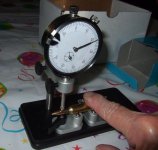M
Montana Pete
Guest
My new Sinclair concentricity guage arrived at the door a few days ago. At that time I happened to have a couple of boxes of ammo already loaded for the 22-250, so I decided to run them through the new guage.
After running one of the boxes through, I identified five cartridges out of the 20 that had more run-out than the others -- around 4 to 5 thousanths of an inch. The others had little or no run-out. I set the former aside.
At the shooting range yesterday I decided to use the five hi-runout shells to warm up the gun before settling down to serious shooting. I expected they would not shoot so good.
The five with the run-out produced a 0.434 inch five-shot group at 100 yds. Subsequent shooting with the "good" rounds did not do this well, producing at best just a 0.75 group.
Not enough rounds were fired to conclude too much, and there was a tricky cross wind that also complicated the picture. But . . . .
. . . . I am beginning to wonder if bullet run-out is very important -- at least, in my present rifle. I may be measuring something that does not have much significance. ? ? ?
I attach a photo of the new guage measuring a 22-250 cartridge. It seems to be a real high-quality product and I wlll continue to use it and try to learn something with it.
After running one of the boxes through, I identified five cartridges out of the 20 that had more run-out than the others -- around 4 to 5 thousanths of an inch. The others had little or no run-out. I set the former aside.
At the shooting range yesterday I decided to use the five hi-runout shells to warm up the gun before settling down to serious shooting. I expected they would not shoot so good.
The five with the run-out produced a 0.434 inch five-shot group at 100 yds. Subsequent shooting with the "good" rounds did not do this well, producing at best just a 0.75 group.
Not enough rounds were fired to conclude too much, and there was a tricky cross wind that also complicated the picture. But . . . .
. . . . I am beginning to wonder if bullet run-out is very important -- at least, in my present rifle. I may be measuring something that does not have much significance. ? ? ?
I attach a photo of the new guage measuring a 22-250 cartridge. It seems to be a real high-quality product and I wlll continue to use it and try to learn something with it.


